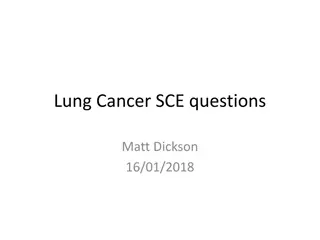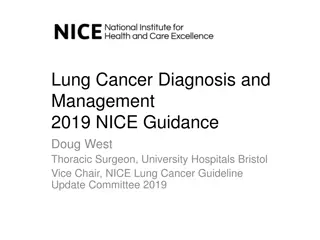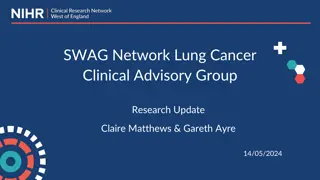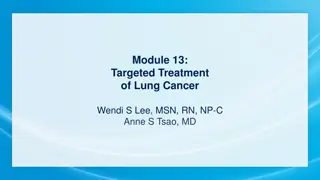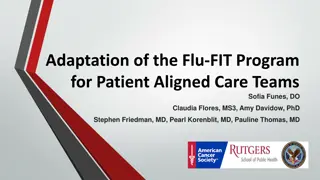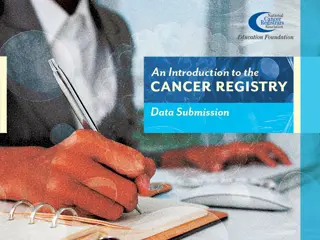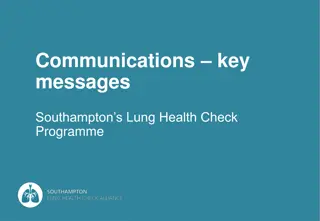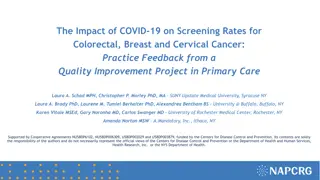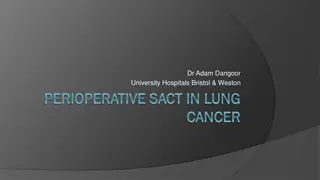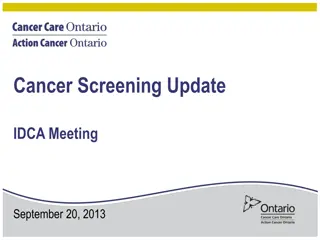Understanding Lung Cancer Screening Programs and Criteria
Screening for lung cancer is essential for early detection and intervention. CT scans have shown promise in reducing mortality rates, especially in high-risk populations. While challenges like cost and radiation risk exist, initiatives like the National Lung Screening Trial have demonstrated the effectiveness of LDCT screening. Inclusion and exclusion criteria, outlined by various groups, help in identifying suitable candidates for screening programs, emphasizing the importance of timely detection and treatment.
Download Presentation

Please find below an Image/Link to download the presentation.
The content on the website is provided AS IS for your information and personal use only. It may not be sold, licensed, or shared on other websites without obtaining consent from the author. Download presentation by click this link. If you encounter any issues during the download, it is possible that the publisher has removed the file from their server.
E N D
Presentation Transcript
Awareness of Lung Cancer GCMA - PP-UNP-IND-0252 5th Jan 2024
Contents Screening Signs/Symptoms Driver mutant lung cancer
Screening of Lung Cancer Screening programs have become a crucial tool in identifying lung cancer at an early stage, facilitating timely intervention and treatment.1 Screening with CT scan is the only test that has been proven to reduce mortality from lung cancer in high-risk populations.2 NLST showed a 20% reduction in mortality when LDCT was used for screening. LDCT has also been shown to be effective in tuberculosis endemic countries as well as in real-life situations such as ours.2 The NLST showed a lung cancer prevalence of 1% in the screened population with the vast majority (63%) of the lung cancers in stage I and a 20% reduction in mortality in this population.2 It s always challenging and difficult to develop an effective lung cancer screening program in India in view of a large number of cases of pulmonary tuberculosis and other chest infections.3 But, cost of LDCT, risk of radiation, false positive finding and over-diagnosis make it difficult to implement at mass level.3 NLST: The National Lung Screening Trial; CT: Computed tomography; LDCT: Low dose CT scan 1. Ramaswamy, Anuradha. Lung Cancer Screening: Review and 2021 Update. Current pulmonology reports vol. 11,1 (2022): 15-28. doi:10.1007/s13665-021-00283-1.2. Parang S, Bhavin J. LDCT Screening in Smokers in India-A Pilot, Proof-of-Concept Study. Indian J Radiol Imaging. 2021 Apr;31(2):318-322. doi: 10.1055/s-0041-1734227. Epub 2021 Jul 28. PMID: 34556914; PMCID: PMC8448241.3. Shankar A, Saini D, Dubey A, Roy S, Bharati SJ, Singh N, Khanna M, Prasad CP, Singh M, Kumar S, Sirohi B, Seth T, Rinki M, Mohan A, Guleria R, Rath GK. Feasibility of lung cancer screening in developing countries: challenges, opportunities and way forward. Transl Lung Cancer Res 2019;8(Suppl 1):S106-S121. doi: 10.21037/tlcr.2019.03.03
Inclusion and exclusion criteria for screening as recommended by various groups 1 USPSTF NLST Quit period for former smokers (years) Quit period for former smokers (years) Age (years) Age (years) Current or former smoking (pack years) Current or former smoking (pack years) 50 80 55 74 < 15 < 15 30 20 X X Additional criteria for inclusion Additional criteria for inclusion Who should not be screened (exclusion or discontinuation) Who should not be screened (exclusion or discontinuation) Asymptomatic Asymptomatic History of LC , Chest CT within 18 months, Hemoptysis, Unexplained weight loss of >15 lb in last year Life-limiting health condition, Unable or unwilling to have curative surgery NLST: National Lung Screening Trial; USPSTF: United States Preventive Services Task Force; LC: Lung cancer; CT: Computed tomography 1. Ramaswamy, Anuradha. Lung Cancer Screening: Review and 2021 Update. Current pulmonology reports vol. 11,1 (2022): 15-28. doi:10.1007/s13665-021-00283-1.
Inclusion and exclusion criteria for screening as recommended by various groups 1 NCCN CMS Quit period for former smokers (years) Quit period for former smokers (years) Age (years) Age (years) Current or former smoking (pack years) Current or former smoking (pack years) 55 77 Gp 1: 55 74 Gp 2: 50 < 15 < 15 30 Gp 1: 30, Gp 2: 20 X Additional criteria for inclusion Additional criteria for inclusion Who should not be screened (exclusion or discontinuation) Gp 1: Asymptomatic Gp 2: One of the following: personal history of cancer or certain chronic lung diseases (COPD, pulmonary fibrosis), family history of LC, radon/occupational exposures Asymptomatic Life-limiting health condition Unable or unwilling to have screening/curative treatment CMS: Centers for Medicare and Medicaid Services; NCCN: National Comprehensive Cancer Network; LC: Lung cancer; COPD: Chronic obstructive pulmonary disease 1. Ramaswamy, Anuradha. Lung Cancer Screening: Review and 2021 Update. Current pulmonology reports vol. 11,1 (2022): 15-28. doi:10.1007/s13665-021-00283-1
Inclusion and exclusion criteria for screening as recommended by various groups 1 IASCLC ACCP ATS ACS ALA ASCO Quit period for former smokers (years) Current or former smoking (pack years) Age (years) Quit period for former smokers (years) Additional criteria for inclusion Asymptomatic Current or former smoking (pack years) Age (years) 55 80 55 74 < 15 30 < 15 30 AAFP AATS LC screening with LDCT not supported currently due to initial concerns about relying on one study alone Quit period for former smokers (years) Additional criteria for inclusion Gp 1: Asymptomatic, Gp 2: Prior history of LC without recurrence x4 years, starting 5 years post-treatment Gp 3: Comorbidities which confer 5% cumulative risk of LC within 5 years Current or former smoking (pack years) Age (years) Gp 1: 55 79 Gp 3: 50 79 Gp 1: < 15 Gp 1: 30, Gp 3: 20 ACCP: American College of Chest Physicians; ATS: American Thoracic Society; IASCLC: International Association for the Study of Lung Cancer; ACS: American Cancer Society; ASCO: American Society of Clinical Oncology; ALA: American Lung Association; AATS: American Association of Thoracic Surgery; AAFP: American Academy of Family Physicians 1. Ramaswamy, Anuradha. Lung Cancer Screening: Review and 2021 Update. Current pulmonology reports vol. 11,1 (2022): 15-28. doi:10.1007/s13665-021-00283-1
Components of a high-quality lung cancer screening program: combined ACCP and ATS policy statement 1 06 01 Who is Offered Lung Cancer Screening? Lung Nodule Management Algorithms 07 Smoking Cessation Programs 02 How often, and for how long, to screen? Components of a high quality LC screening program Patient and Provider Education Programs 03 How the CT Scan is Performed? 08 09 04 Structured Reporting 05 Lung Nodule Identification Data Collection ACCP: American College of Chest Physicians; ATS: American Thoracic Society; LC: Lung Cancer; CT scan: Computed Tomography 1. Ramaswamy, Anuradha. Lung Cancer Screening: Review and 2021 Update. Current pulmonology reports vol. 11,1 (2022): 15-28. doi:10.1007/s13665-021-00283-1
Components of a high-quality lung cancer screening program: combined ACCP and ATS policy statement 1,2 Who is offered lung cancer screening? 01 04 Lung nodule identification programs Those meeting USPSTF criteria Those who will benefit; without significant comorbidities Risk data of enrolled patients should be Collected by the program Have a policy to determine the size and characteristics of positive nodules Collect nodule data (number, size, characteristics) from positive scans 02 How often, and for how long, to screen? Annually until 80 years of age if surgical candidate Stop if patient quits smoking> 15 years ago or develops life-limiting disorder 05 Data collection Data should be collected on patients enrolled, the other 8 components listed here, and outcomes of testing and details of diagnosed cancers An annual data review with a plan for quality improvement should occur Annual reporting of collected data to an oversight agency with credentialing authority should be performed 03 How the CT Scan is performed? Low dose computed tomography -Technical specifications of ACR- STR should be met Mean radiation dose data should be collected to ensure compliance with ACR-STR recommendations ATS: American Thoracic Society; USPSTF: U.S. Preventive Services Task Force; ACCP: American College of Chest Physicians; CT: Computed tomography; ACR-STR American College of Radiology (ACR) and the Society of Thoracic Radiology (STR) 1. Ramaswamy, Anuradha. Lung Cancer Screening: Review and 2021 Update. Current pulmonology reports vol. 11,1 (2022): 15-28. doi:10.1007/s13665-021-00283-1. 2. Mazzone, Peter J et al. Screening for Lung Cancer: CHEST Guideline and Expert Panel Report. Chest vol. 160,5 (2021): e427-e494. doi:10.1016/j.chest.2021.06.063
Components of a high-quality lung cancer screening program: combined ACCP and ATS policy statement 1,2 06 Lung nodule management algorithms 08 Patient & provider education programs Clinicians responsible for management, based on nodule size and characteristics, should be identified Care pathways for lung nodule management should be developed Multidisciplinary review such as tumor board conference is recommended Nodule follow-up should be tracked Imaging, procedural and surgical resources should be available for further management Timely communication of results and follow-up plans of nodules and incidental findings should occur Data should be collected on surveillance, outcomes and further management Offer education to providers discussing benefits and harms of screening with patients Develop or use standardized education materials Be in charge of provider-based patient education 09 Structured reporting Lung-RADS or an alternative structured reporting system should be used Compliance data relating to use of such a reporting system should be collected 07 Smoking cessation programs Have an integrated smoking cessation program Collect data regarding cessation interventions offered to current smokers ACCP: American College of Chest Physicians; ATS: ATS American Thoracic Society; Lung-RADS: Lung Imaging Reporting and Data System 1. Ramaswamy, Anuradha. Lung Cancer Screening: Review and 2021 Update. Current pulmonology reports vol. 11,1 (2022): 15-28. doi:10.1007/s13665-021-00283-1. 2. Mazzone, Peter J et al. Screening for Lung Cancer: CHEST Guideline and Expert Panel Report. Chest vol. 160,5 (2021): e427-e494. doi:10.1016/j.chest.2021.06.063
Pitfalls of screening1 Psychosocial Impact False Negatives or Missed Diagnoses Patients can develop anxiety, depression, and psychological distress over screening results, diagnosis of cancer, or related to complications. These occur due to observer error, characteristics of the lesion or technical error, and can have medicolegal consequences. Over diagnosis Radiation Exposure This can lead to unnecessary procedures, and contribute to morbidity, anxiety, and expense. Radiation exposure: CXR - 0.1mSV, LDCT- 1.5 mSV, full-dose CT scan- 8 mSV, PET-CT- 14 mSV. There is a cancer risk from Exposure to ionizing radiation during scanning, which is cumulative throughout life . False Positives Increasing the threshold for nodule detection can decrease false positives at the risk of decreasing sensitivity. Invasive Procedures and Complications The invasive procedure rates are reported to be approximately 5.1% and 2.7% after screening with LDCT and CXR, respectively, with complication rates also higher in patients who were screen-positive by LDCT compared to CXR. CXR: chest X-ray ; CT: Computed tomography; PET-CT: Positron Emission Tomography and Computed Tomography; LDCT: Low dose CT scan; CXR: chest X-ray 1. Ramaswamy, Anuradha. Lung Cancer Screening: Review and 2021 Update. Current pulmonology reports vol. 11,1 (2022): 15-28. doi:10.1007/s13665-021-00283-1
Biomarkers in screening1 Auto antibodies Complement fragments Circulating DNA & microRNA signature profiles Circulating proteins Following biomarkers are being studied Image analysis of sputum Exhaled breath condensates Artificial intelligence based sputum cytology Airway gene expression Metabolomics Currently being utilized in patients with lung nodules to assist with lung cancer risk stratification DNA: Deoxyribonucleic acidDNA Deoxyribonucleic acid; RNA: Ribonucleic acid 1. Ramaswamy, Anuradha. Lung Cancer Screening: Review and 2021 Update. Current pulmonology reports vol. 11,1 (2022): 15-28. doi:10.1007/s13665-021-00283-1.
Summary of Screening Recommendations 1 In patients at risk for developing lung cancer, screening for lung cancer with chest radiograph (CXR) once or at regular intervals is not recommended (Grade 1 A) In patients at risk for developing lung cancer, screening for lung cancer with sputum cytology at regular intervals is not suggested (Grade 2A) For smokers and former smokers who are age 55 to 74 and who have smoked for 30 pack-years or more and either continue to smoke or have quit within the past 15 years, we suggest that annual screening with low-dose CT (LDCT) should be offered over both annual screening with CXR or no screening, but only in settings that can deliver the comprehensive care provided to National Lung Screening Trial participants (Grade 2B) For individuals who have accumulated fewer than 30 pack-years of smoking or are either younger than age 55 or older than 74, or individuals who quit smoking more than 15 years ago, and for individuals with severe comorbidities that would preclude potentially curative treatment and/or limit life expectancy, we suggest that CT screening should not be performed (Grade 2C) * The information provided is not based on Indian guidelines. CXR: Chest X-ray; CT: Computed tomography; LDCT: Low dose CT scan; 1. Detterbeck FC, Mazzone PJ, Naidich DP, Bach PB. Screening for lung cancer: Diagnosis and management of lung cancer, 3rd ed: American College of Chest Physicians evidence-based clinical practice guidelines. Chest. 2013 May;143(5 Suppl):e78S-e92S. doi: 10.1378/chest.12-2350. PMID: 23649455; PMCID: PMC3749713.
Summary of Screening Recommendations 1 Screening for lung cancer involves a complex interplay of patient selection, counselling, risk modification, an organized process for screening and scan interpretation, and judgment to minimize further testing to only those instances in which it is necessary.1 ` With attention to detail and ongoing refinement of the process, LDCT screening for lung cancer has the potential to have a major impact on the reduction of cancer deaths.1 * The information provided is not based on Indian guidelines. LDCT: Low dose CT scan; 1. Detterbeck FC, Mazzone PJ, Naidich DP, Bach PB. Screening for lung cancer: Diagnosis and management of lung cancer, 3rd ed: American College of Chest Physicians evidence-based clinical practice guidelines. Chest. 2013 May;143(5 Suppl):e78S-e92S. doi: 10.1378/chest.12-2350. PMID: 23649455; PMCID: PMC3749713.
Signs / Symptoms of Lung Cancer 1. The earliest stage of lung cancer is often not associated with any symptoms.1 2. The most common symptoms associated with lung cancer tend to be both common in benign presentations in the community and particularly amongst smokers.1 3. Therefore, the discriminative utility of most of these symptoms in isolation is low.1 4. Positive predictive values (PPVs) for different symptoms of lung cancer, both alone and in combination, have been determined from a case control study and is presented below.1 Positive predictive values (%) for lung cancer for individual risk markers, and for pairs of risk markers in the PPV. These have not been calculated when any cell in the 2 2 table was below 10. combination (against a background risk of 0.18%). (1) The top row (bold) gives the PPV for an individual feature. The cells along the diagonal relate to the PPV when the same feature has been reported twice. Other cells show the PPV when a patient has two different features. (2) The top figure in each cell is the PPV. It has only been calculated when a minimum of ten cases had the feature or combination of features. The two other figures are the 95% CIs for (3) The light blue shading is when the PPV is above 1%. The mid blue shading is when the PPV is above 2%. The dark blue shading is for PPVs above 5.0% PPVs: Positive predictive values 1. Bradley SH, Kennedy MPT, Neal RD. Recognising Lung Cancer in Primary Care. Adv Ther. 2019 Jan;36(1):19-30. doi: 10.1007/s12325-018-0843-5. Epub 2018 Nov 29. Erratum in: Adv Ther. 2020 Apr;37(4):1701. PMID: 30499068; PMCID: PMC6318240.
Clinical Manifestations of Lung cancer Occurs in Lung cancers arising in the superior sulcus. Manifested by pain (usually in the shoulder, and less commonly in the arm, scapula, and fingers), Horner syndrome, bony destruction, and atrophy of hand muscles Pancoast syndrome Present in 50 to 75 percent of lung cancer patients Intrathoracic clinical manifestations1 Chest pain Cough Present in approximately 20 to 40 percent of patients Reported by 15 to 30 percent of patients Hemoptysis 1. UpToDate. Clinical manifestations of Lung Cancer. https://www.uptodate.com/contents/clinical-manifestations-of-lung-cancer. Access Date: Nov 6, 2023
Clinical Manifestations of Lung cancer During the course of disease, approximately 10 to 15 percent of lung cancer patients have a malignant pleural effusion1 More common in patients with SCLC than NSCLC1,2 Pleural involvement (Can occur in both right and left side due to lymph node involvement) Dyspnea (shortness of breath) Intrathoracic clinical manifestations1 Superior vena cava syndrome Present in approximately 25 to 40 percent of patients1 Hoarseness SCLC: Small cell lung cancer; NSCLC: NSCLC Non-Small Cell Lung Cancer 1. American Cancer Society. Signs and Symptoms of Lung Cancer. Lung Cancer Signs & Symptoms | Common Symptoms of Lung Cancer Access Date: Jan 30, 2024 2. Cohen R, Mena D, Carbajal-Mendoza R, Matos N, Karki N. Superior vena cava syndrome: A medical emergency? Int J Angiol. 2008 Spring;17(1):43-6. doi: 10.1055/s-0031-1278280. PMID: 22477372; PMCID: PMC2728369.
Clinical Manifestations of Lung cancer Bone: Metastasis from lungs to bone includes pain in the back, chest, or extremity and elevated levels of serum alkaline phosphatase. Constitutional Symptoms: Includes weight loss, anorexia, weakness, and fatigue. Clinical Adrenal: Adrenal metastasis may have localized symptoms (eg: back or abdominal pain) if the tumor is large or rapidly growing or has caused a retroperitoneal hemorrhage. manifestations of extrathoracic metastases1 Liver: Hepatic metastasis is uncommon, and are detected by liver enzyme abnormalities, CT, PET. Brain: Neurologic manifestations of lung cancer include metastases and paraneoplastic syndromes. Symptoms from central nervous system metastasis are similar to those with other tumors and include headache, vomiting, visual field loss, hemiparesis, cranial nerve deficit, and seizures. CT: Computed tomography; PET: Positron emission tomography 1. UpToDate. Clinical manifestations of Lung Cancer. https://www.uptodate.com/contents/clinical-manifestations-of-lung-cancer. Access Date: Nov 6, 2023
Clinical Manifestations of Lung cancer Paraneoplastic phenomena1 SIADH secretion - The syndrome of inappropriate antidiuretic hormone secretion (SIADH) is frequently caused by SCLC and results in hyponatremia. Approximately 10 percent of patients who have SCLC exhibit SIADH. SCLC accounts for approximately 75 percent of all malignancy-related occurrences of SIADH. Hypercalcemia - (Symptoms of hypercalcemia include anorexia, nausea, vomiting, constipation, lethargy, polyuria, polydipsia, and dehydration. Confusion and coma are late manifestations as are renal failure and nephrocalcinosis). Neurologic syndromes - Includes Lambert-Eaton myasthenic syndrome (LEMS), cerebellar ataxia, sensory neuropathy, limbic encephalitis, encephalomyelitis, autonomic neuropathy, retinopathy, and opsomyoclonus. LEMS: Lambert-Eaton myasthenic syndrome; SCLC: Small cell lung cancer; SIADH: syndrome of inappropriate antidiuretic hormone secretion 1. UpToDate. Clinical manifestations of Lung Cancer. https://www.uptodate.com/contents/clinical-manifestations-of-lung-cancer. Access Date: Nov 6, 2023
Clinical Manifestations of Lung cancer Hypertrophic osteoarthropathy1 Characterized by a symmetrical, painful arthropathy and long-bone pain that usually involves the ankles, knees, wrists, and elbows. The metacarpal, metatarsal, and phalangeal bones may also be involved. Dermatomyositis and polymyositis1 Hematologic manifestations1 Anemia Leukocytosis Thrombocytosis Eosinophilia Hypercoagulable disorders: Superficial thrombophlebitis (Trousseau syndrome) Deep venous thrombosis and thromboembolism Disseminated intravascular coagulopathy Thrombotic microangiopathy Nonbacterial thrombotic endocarditis These are two distinct forms of inflammatory myopathy, both of which are manifested clinically by muscle weakness. Cushing syndrome1 Patients typically present with muscle weakness, weight gain, hypertension, hirsutism, and osteoporosis. Cushing syndrome is rare, but is most commonly seen in patients with SCLC, large cell neuroendocrine carcinoma, or carcinoid tumors of the lung. SCLC: Small cell lung cancer; 1. UpToDate. Clinical manifestations of Lung Cancer. https://www.uptodate.com/contents/clinical-manifestations-of-lung-cancer. Access Date: Nov 6, 2023
Driver mutant Lung Cancer Oncogenic driver mutations initiate and sustain cancer by affecting genes that encode vital signalling proteins for cellular growth and survival.1 Many trials are ongoing, some of them through serial tumor or plasma biopsies and multiplex molecular testing.2 A significant proportion of lung cancer patients present alterations in certain genes that drive oncogenesis.2 EGFR exon 19 mutations are common followed by the ALK fusion and ROS 1 fusion3,4 Currently, more than fifteen targeted agents are FDA-approved for seven oncogenic drivers in non- small-cell lung cancer, highlighting the importance of actively searching for these mutations.2 EGFR: Epidermal growth factor receptor; ALK: Anaplastic lymphoma kinase; ROS1: c-ROS oncogene 1 1. Luo SY, Lam DC. Oncogenic driver mutations in lung cancer. Transl Respir Med. 2013 Dec;1(1):6. doi: 10.1186/2213-0802-1-6. Epub 2013 Mar 8. PMID: 27234388; PMCID: PMC6733434. 2. Chevallier M, Borgeaud M, Addeo A, Friedlaender A. Oncogenic driver mutations in non-small cell lung cancer: Past, present and future. World J Clin Oncol 2021; 12(4): 217-237 3. Noronha V, Pinninti R, Patil VM, Joshi A, Prabhash K. Lung cancer in the Indian subcontinent. South Asian J Cancer. 2016 Jul-Sep;5(3):95-103. doi: 10.4103/2278-330X.187571. PMID: 27606290; PMCID: PMC4991146. 4. Tarigopula, Anil et al. EGFR mutations and ROS1 and ALK rearrangements in a large series of non-small cell lung cancer in South India. Cancer reports (Hoboken, N.J.) vol. 3,6 (2020): e1288. doi:10.1002/cnr2.1288
Incidence of oncogenic drivers in non-small cell lung cancer1 ALK RET 3%3% 1% 1% ROS1 MET NTRK 0% 0% NRG1 HER2 3% 5% 29% KRAS BRAF 9% Other Genes EGFR 19% Unknown 27% KRAS Unknown EGFR Other Genes BRAF HER2 MET ALK RET ROS1 NTRK NRG1 ORR: Objective response rate; PFS: Progression-free survival; OS: Overall survival; EGFR: Epidermal growth factor receptor; ALK: Anaplastic lymphoma kinase; ROS1: c-ROS oncogene 1; NTRK: Neurotrophic receptor tyrosine kinase; RET: Rearranged during transfection; KRAS: Kirsten rat sarcoma; HER2: Human epidermal growth factor 2; NRG1: Neuregulin-1; BRAF: V-raf murine sarcoma viral oncogene homolog B. NA: Not available. 1. Chevallier M, Borgeaud M, Addeo A, Friedlaender A. Oncogenic driver mutations in non-small cell lung cancer: Past, present and future. World J Clin Oncol 2021; 12(4): 217-237
A suggested schema for guidance of clinical testing for oncogenic driver mutations which aid in personalized treatment in lung cancer. 1 Lung Cancer Histology based Small Cell Lung Cancer (SCLC) Non-Small-Cell Lung Cancer (N SCLC) Large Cell Carcinoma (LCC) Squamous Cell Carcinoma (SCC) Adenocarcinoma (AD) Mutation Profiling by NGS Therapeutic decision & Clinical Outcome EGFR Mutation Primary Resistance To TKI Other molecular driving mutations : KRAS, EML4-ALK, MET, etc TKI Responsive KRAS: Kirsten rat sarcoma; EGFR: Epidermal growth factor receptor; TKI: Tyrosine kinase inhibitors; ALK: Anaplastic lymphoma kinase; NGS Next generation sequencing; EML4-ALK: echinoderm microtubule-associated protein-like 4-anaplastic lymphoma kinase; MET: Mesenchymal epithelial transition factor receptor 1.Luo SY, Lam DC. Oncogenic driver mutations in lung cancer. Transl Respir Med. 2013 Dec;1(1):6. doi: 10.1186/2213-0802-1-6. Epub 2013 Mar 8. PMID: 27234388; PMCID: PMC6733434.
Selected oncogenic drivers and their treatments in non-small cell lung cancer1-4 OS Targeted therapy ORR PFS EGFR 19.3 26.3 mo 62% - 83% 9.7 -13.1 mo Erlotinib 22 mo 73.70% 9.5 mo Gefitinib 25.8 mo 56% - 67% 11.1 mo Afatinib 34 mo 74.90% 14.7 mo Dacomitinib 38.6 mo 80% 18.9 mo Osimertinib ORR: Objective response rate; PFS: Progression-free survival; OS: Overall survival; EGFR: Epidermal growth factor receptor; mo: Months 1. Chevallier M, Borgeaud M, Addeo A, Friedlaender A. Oncogenic driver mutations in non-small cell lung cancer: Past, present and future. World J Clin Oncol 2021; 12(4): 217-237
Selected oncogenic drivers and their treatments in non-small cell lung cancer1 OS Targeted therapy ORR PFS ALK 57 mo 75.50% 11 mo Crizotinib NA 72.50% 16.6 mo Ceritinib NA 79% 24 mo Brigatinib NA 82.90% 35 mo Alectinib NA 76% NA Lorlatinib OS Targeted therapy ORR PFS Crizotinib ROS1 51 mo 63-72% 15.9 19.2 mo Lorlatinib NA 62% 19.3 mo Entrectinib NA 77% 19 mo ORR: Objective response rate; PFS: Progression-free survival; OS: Overall survival; ALK: Anaplastic lymphoma kinase; ROS1: c-ROS oncogene 1; mo : Months; NA: Not available; 1. Chevallier M, et al. Oncogenic driver mutations in NSCLC: Past, present, future. World J Clin Oncol 2021; 12(4): 217-237.
Selected oncogenic drivers and their treatments in non-small cell lung cancer1 OS Targeted therapy ORR PFS MET NA 32% 7.3 mo Crizotinib NA NA NA Cabozatinib NA 68% 9.7 mo Capmatinib NA 46% NA Tepotinib OS Targeted therapy ORR PFS Dabrafenib- BRAF 24.6 mo 64% 10.9 mo trametinib OS Targeted therapy ORR PFS Trastuzumab- HER2 62% NA 14 mo deruxtecan ORR: Objective response rate; PFS: Progression-free survival; OS: Overall survival; HER2: Human epidermal growth factor 2; BRAF: V-raf murine sarcoma viral oncogene homolog B. ; MET: Mesenchymal epithelial transition factor receptor; mo : Months; NA: Not available 1. Chevallier M, Borgeaud M, Addeo A, Friedlaender A. Oncogenic driver mutations in non-small cell lung cancer: Past, present and future. World J Clin Oncol 2021; 12(4): 217-237
Selected oncogenic drivers and their treatments in non-small cell lung cancer1 OS Targeted therapy ORR PFS NTRK NA 70% NA Entrectinib NA 75% NA Larotrectinib OS Targeted therapy ORR PFS Selpercatinib RET NA 85% NA Pralsetinib NA 70% NA OS Targeted therapy ORR PFS Sotorasib KRAS 32.20% NA 10.2 mo Adagrasib 45% NA NA ORR: Objective response rate; PFS: Progression-free survival; OS: Overall survival; NTRK: Neurotrophic receptor tyrosine kinase; RET: Rearranged during transfection; KRAS: Kirsten rat sarcoma; NA: Not available.; mo:Months 1. Chevallier M, Borgeaud M, Addeo A, Friedlaender A. Oncogenic driver mutations in non-small cell lung cancer: Past, present and future. World J Clin Oncol 2021; 12(4): 217-237
In the 20th century, every gene matters, and it would be unethical to deny patients access to proven targeted therapies given the efficacy and favourable toxicity profile of such drugs.1 Barring a therapeutic emergency, no patient should be started on systemic therapy before a comprehensive molecular analysis has been completed.1 Since 2018, ASCO has recommended routine mutation testing for driver genes including EGFR, ALK, ROS1 and BRAF in clinical practice for patients with metastatic NSCLC.1 NGS has the potential and benefit of providing all the relevant biomarkers in a single test thus saving valuable time and biopsy tissue2 Understanding into the biological mechanisms underlying these oncogenic driver mutations, the clinical relevance of these driver mutations will allow for further advancement into targeted therapeutics in lung cancer.2 ASCO: American Society of Clinical Oncology; EGFR: epidermal growth factor receptor; ALK: anaplastic lymphoma kinase; ROS1: receptor tyrosine kinase; BRAF: B-raf proto-oncogene; NSCLC: Non-Small Cell Lung Cancer; NGS: Next generation sequencing 1.Chevallier M, Borgeaud M, Addeo A, Friedlaender A. Oncogenic driver mutations in non-small cell lung cancer: Past, present and future. World J Clin Oncol 2021; 12(4): 217-237 2. Ewalt MD, West H, Aisner DL. Next Generation Sequencing Testing Multiple Genetic Markers at Once. JAMA Oncol. 2019;5(7):1076. doi:10.1001/jamaoncol.2019.0453
References : Ramaswamy, Anuradha. Lung Cancer Screening: Review and 2021 Update. Current pulmonology reports vol. 11,1 (2022): 15-28. doi:10.1007/s13665-021-00283-1 Parang S, Bhavin J. LDCT Screening in Smokers in India-A Pilot, Proof-of-Concept Study. Indian J Radiol Imaging. 2021 Apr;31(2):318-322. doi: 10.1055/s-0041-1734227. Epub 2021 Jul 28. PMID: 34556914; PMCID: PMC8448241. Shankar A, Saini D, Dubey A, Roy S, Bharati SJ, Singh N, Khanna M, Prasad CP, Singh M, Kumar S, Sirohi B, Seth T, Rinki M, Mohan A, Guleria R, Rath GK. Feasibility of lung cancer screening in developing countries: challenges, opportunities and way forward. Transl Lung Cancer Res 2019;8(Suppl 1):S106-S121. doi: 10.21037/tlcr.2019.03.03 Mazzone, Peter J et al. Screening for Lung Cancer: CHEST Guideline and Expert Panel Report. Chest vol. 160,5 (2021): e427-e494. doi:10.1016/j.chest.2021.06.063 Detterbeck FC, Mazzone PJ, Naidich DP, Bach PB. Screening for lung cancer: Diagnosis and management of lung cancer, 3rd ed: American College of Chest Physicians evidence-based clinical practice guidelines. Chest. 2013 May;143(5 Suppl):e78S-e92S. doi: 10.1378/chest.12-2350. PMID: 23649455; PMCID: PMC3749713. Bradley SH, Kennedy MPT, Neal RD. Recognising Lung Cancer in Primary Care. Adv Ther. 2019 Jan;36(1):19-30. doi: 10.1007/s12325-018-0843-5. Epub 2018 Nov 29. Erratum in: Adv Ther. 2020 Apr;37(4):1701. PMID: 30499068; PMCID: PMC6318240. UpToDate. Clinical manifestations of Lung Cancer. https://www.uptodate.com/contents/clinical-manifestations-of-lung-cancer. Access Date: Nov 6, 2023 Cohen R, Mena D, Carbajal-Mendoza R, Matos N, Karki N. Superior vena cava syndrome: A medical emergency? Int J Angiol. 2008 Spring;17(1):43-6. doi: 10.1055/s-0031-1278280. PMID: 22477372; PMCID: PMC2728369. Luo SY, Lam DC. Oncogenic driver mutations in lung cancer. Transl Respir Med. 2013 Dec;1(1):6. doi: 10.1186/2213-0802-1-6. Epub 2013 Mar 8. PMID: 27234388; PMCID: PMC6733434. Chevallier M, Borgeaud M, Addeo A, Friedlaender A. Oncogenic driver mutations in non-small cell lung cancer: Past, present and future. World J Clin Oncol 2021; 12(4): 217-237 Noronha V, Pinninti R, Patil VM, Joshi A, Prabhash K. Lung cancer in the Indian subcontinent. South Asian J Cancer. 2016 Jul-Sep;5(3):95-103. doi: 10.4103/2278-330X.187571. PMID: 27606290; PMCID: PMC4991146. Tarigopula, Anil et al. EGFR mutations and ROS1 and ALK rearrangements in a large series of non-small cell lung cancer in South India. Cancer reports (Hoboken, N.J.) vol. 3,6 (2020): e1288. doi:10.1002/cnr2.1288 Ewalt MD, West H, Aisner DL. Next Generation Sequencing Testing Multiple Genetic Markers at Once. JAMA Oncol. 2019;5(7):1076. doi:10.1001/jamaoncol.2019.0453 GCMA - PP-UNP-IND-0252 5th Jan 2024 For the use only of Registered Medical Practitioners or a Hospital or a Laboratory Pfizer Products India Pvt Ltd, The Capital, B Wing 1802, 18th Floor, Plot No. C-70, G Block, Bandra Kurla Complex, Bandra (East), Mumbai 400051, India









